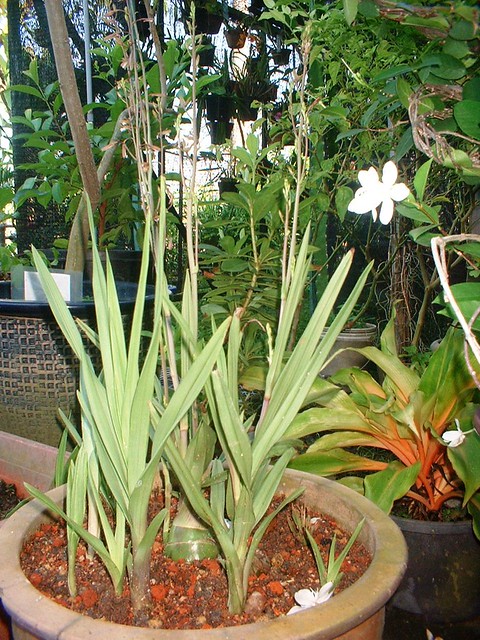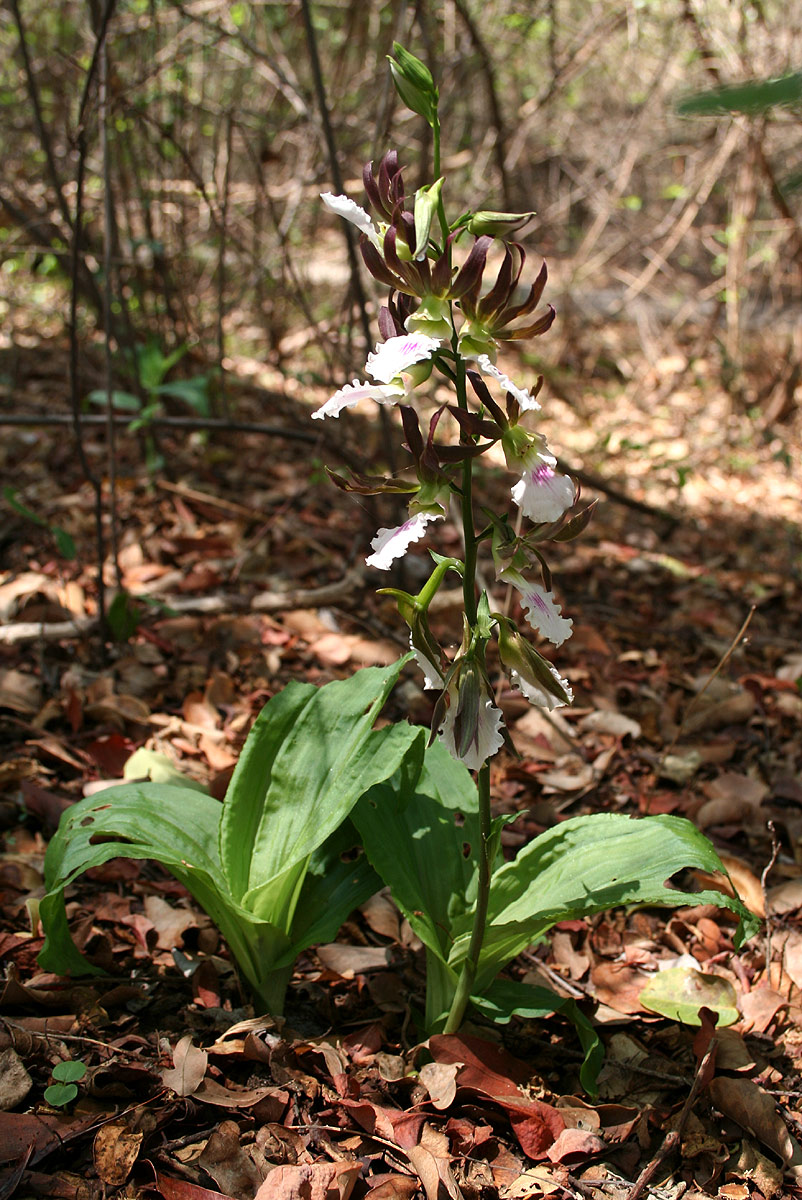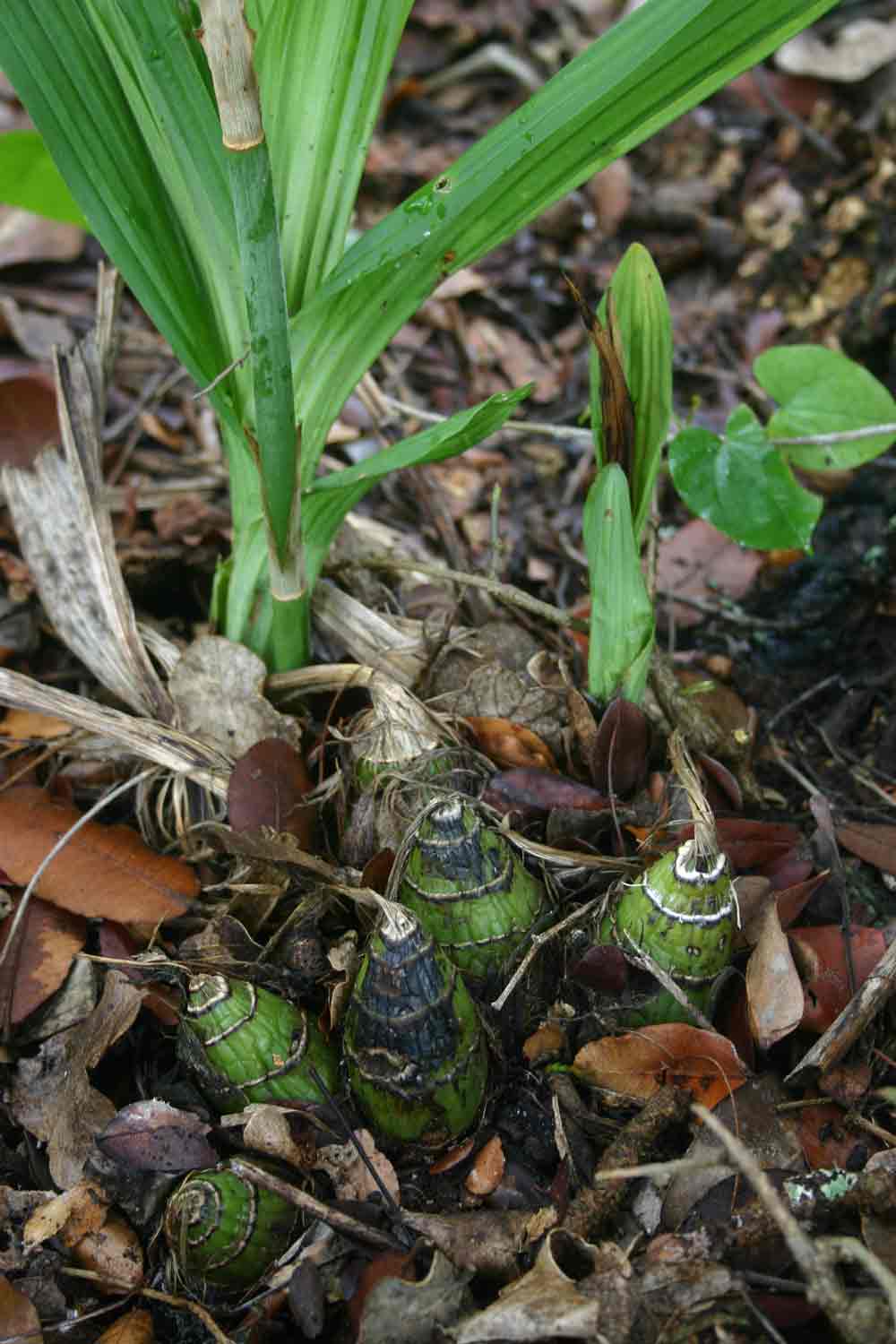The genus Eulophia, which also constitutes the monogeneric alliance Eulophia, includes 210 species of orchids. It was first described by John Lindley
in 1821. The name "Eulophia" was derived from the Greek words "eu"
(well) and "lophos" (plume), referring to the crested ridges of the labellum (lip) in most species. This genus is abbreviated Eupha in horticultural trade.
These are usually terrestrial or ground orchids, although some are epiphytes, and rarely, lithophytes. They are distributed in shady rainforests or in open scrub or woodland in the tropics and subtropics of Africa, India,[1] Asia, Queensland (Australia), and the Americas, although most are found in Africa. Many can survive the dry season through their large bulbous ‘corms’.
Some species, such as Eulophia petersii, have adapted to very arid environments and are among the few orchids to have truly evolved desert living species. In the frost-free, semi-arid areas of Southern California, many Eulophia species, such as E. macra, E. petersii, E. plantaginea, and E. speciosa, can be grown outdoors year-round in well-drained pots with cactus/succulent potting mix (although E. speciosa prefers being grown in pure white sand), as long as they are given ample light through the winter and a drier winter resting period. Warmer growers, such as E. pulchra, E. keithii, and possibly even the extremely rare and difficult E. cucullata (the foxglove orchid), can probably be grown outdoors in the warmer areas of Florida and Hawaii, also.
The deciduous or evergreen leaves are usually pleated, with longitudinal veins. They are green and sheathed at the base. But in some species, the leaves may be reduced or have become brown scales. Some are leafless myco-heterotrophs.
The generally large, underground, fleshy rhizome indicates a sympodial growth habit, and this makes Eulophias fairly easy to divide and propagate, provided the grower is gentle.
The inflorescence arises from the base. It grows into a raceme. It is sometimes branched, as in the cases of E. macra and E. petersii. The inflorescences on the species with non-brancing spikes can support as many as 50 flowers; but in species with branching inflorescences, up to 150 blooms can occur per spike. While most Eulophia flowers rarely exceed 2" in width, this is often made up for by the sheer abundance of interesting blooms they produce. The sepals and the petals are alike. The lip usually has three lobes. As for most orchids, there are two pollinia for each flower. Eulophias (in bloom) can reach a height of 1.6 m (6 ft.). In any case, the ease of cultivation and reliability of blooming that many Eulophia species and hybrids demonstrate in captivity, in addition to their unique growth habits, makes them generally excellent orchids for amateur orchid collectors and people who like to grow plants with interesting flowers.
Synonyms
These are usually terrestrial or ground orchids, although some are epiphytes, and rarely, lithophytes. They are distributed in shady rainforests or in open scrub or woodland in the tropics and subtropics of Africa, India,[1] Asia, Queensland (Australia), and the Americas, although most are found in Africa. Many can survive the dry season through their large bulbous ‘corms’.
Some species, such as Eulophia petersii, have adapted to very arid environments and are among the few orchids to have truly evolved desert living species. In the frost-free, semi-arid areas of Southern California, many Eulophia species, such as E. macra, E. petersii, E. plantaginea, and E. speciosa, can be grown outdoors year-round in well-drained pots with cactus/succulent potting mix (although E. speciosa prefers being grown in pure white sand), as long as they are given ample light through the winter and a drier winter resting period. Warmer growers, such as E. pulchra, E. keithii, and possibly even the extremely rare and difficult E. cucullata (the foxglove orchid), can probably be grown outdoors in the warmer areas of Florida and Hawaii, also.
The deciduous or evergreen leaves are usually pleated, with longitudinal veins. They are green and sheathed at the base. But in some species, the leaves may be reduced or have become brown scales. Some are leafless myco-heterotrophs.
The generally large, underground, fleshy rhizome indicates a sympodial growth habit, and this makes Eulophias fairly easy to divide and propagate, provided the grower is gentle.
The inflorescence arises from the base. It grows into a raceme. It is sometimes branched, as in the cases of E. macra and E. petersii. The inflorescences on the species with non-brancing spikes can support as many as 50 flowers; but in species with branching inflorescences, up to 150 blooms can occur per spike. While most Eulophia flowers rarely exceed 2" in width, this is often made up for by the sheer abundance of interesting blooms they produce. The sepals and the petals are alike. The lip usually has three lobes. As for most orchids, there are two pollinia for each flower. Eulophias (in bloom) can reach a height of 1.6 m (6 ft.). In any case, the ease of cultivation and reliability of blooming that many Eulophia species and hybrids demonstrate in captivity, in addition to their unique growth habits, makes them generally excellent orchids for amateur orchid collectors and people who like to grow plants with interesting flowers.
Synonyms
- Cyrtopera Lindl.
- Hypodematium A. Rich.
- Lissochilus R. Br.
- Orthochilus Hochst. ex A. Rich.
- Platypus Small & Nash
- Semiphajus Gagnep.
- Thysanochilus Falc.
Species
- Eulophia abyssinica (Northeast tropical Africa)
- Eulophia aculeata (southern Africa)
- Eulophia aculeata subsp. aculeata (southern Africa)
- Eulophia aculeata subsp. huttonii (southern Africa)
- Eulophia acutilabra (South Congo to southern tropical Africa)
- Eulophia adenoglossa (tropical and southern Africa)
- Eulophia albobrunnea (Ethiopia).
- Eulophia aloifolia (Angola)
- Eulophia alta - wild coco (tropical Africa, South Florida, Mexico to tropical America)
- Eulophia alta var. alba (Central and West Brazil)
- Eulophia amblyosepala (Uganda)
- Eulophia andamanensis (Indo-China to North Sumatra)
- Eulophia angolensis - yellow swamp orchid (tropical and southern Africa)
- Eulophia angustilabris (Thailand)
- Eulophia anjoanensis (Comoros)
- Eulophia antennisepala (Angola)
- Eulophia antunesii (Angola)
- Eulophia arenicola (South Congo to Botswana)
- Eulophia aurantiaca (Burundi to Zambia)- now synonym of Eulophia welwitschii Rolfe subsp. aurantiaca (Rolfe)
- Eulophia barteri (West tropical Africa to Central African Republic).
- Eulophia beravensis (Madagascar)
- Eulophia bicallosa (Taiwan, tropical Asia to North Australia)
- Eulophia biloba (Mozambique)
- Eulophia bisaccata (Mozambique ?)
- Eulophia borbonica (Réunion)
- Eulophia borneensis (Borneo, Sarawak)
- Eulophia bouliawongo (Nigeria to Angola)
- Eulophia bracteosa (Assam to South Central China)
- Eulophia brenanii (South Congo to North Zambia)
- Eulophia buettneri (West tropical Africa to Cameroon)
- Eulophia burmanica (Myanmar)
- Eulophia calantha (Guinea, Central African Republic to Uganda and southern tropical Africa)
- Eulophia calanthoides (southern Africa)
- Eulophia callichroma (Tanzania to Swaziland)
- Eulophia campanulata (Uttarakhand,Western Himalaya)
- Eulophia campbellii (East India)
- Eulophia caricifolia (tropical Africa)
- Eulophia carsonii (Tanzania to Zambia)
- Eulophia chaunanthe (Thailand)
- Eulophia chilangensis (South Congo to Angola)
- Eulophia chlorantha (Southeast Mpumalanga to Northwest Swaziland, South Africa)
- Eulophia chrysoglossoides (North Borneo)
- Eulophia clandestina (Angola)
- Eulophia clavicornis (Ethiopia to southern Africa, Madagascar, Southwest Arabian Pen)
- Eulophia clavicornis var. clavicornis (Zimbabwe to southern Africa)
- Eulophia clavicornis var. inaequalis (Zimbabwe to southern Africa)
- Eulophia clavicornis var. nutans (Ethiopia to southern Africa, Madagascar, Southwest Arabian Pen)
- Eulophia clitellifera (tropical and southern Africa, Madagascar)
- Eulophia coccifera (Réunion)
- Eulophia coddii (Northern Prov. of South Africa)
- Eulophia coeloglossa (Tanzania to southern Africa)
- Eulophia cooperi (southern Africa)
- Eulophia corymbosa (Angola)
- Eulophia cristata (West tropical Africa to Ethiopia)
- Eulophia cucullata (tropical and southern Africa, Madagascar)
- Eulophia dabia (Afghanistan to South China)
- Eulophia dactylifera (southern tropical Africa)
- Eulophia dahliana (New Guinea to Bismarck Islands)
- Eulophia decaryana (Madagascar) (homotypic synonym of Oeceoclades decaryana (H.Perrier) Garay & P.Taylor, 1976 )
- Eulophia densiflora (East Himalaya)
- Eulophia dentata (Luzon)
- Eulophia distans (Sierra Leone)
- Eulophia divergens (Angola)
- Eulophia dufossei (Indo-China)
- Eulophia ecristata - smooth-lipped eulophia (Southwest U.S.A. to Cuba)
- Eulophia elegans (Cameroon, Southwest Tanzania to Malawi)
- Eulophia emilianae (Southwest India)
- Eulophia ensata (Mozambique to southern Africa)
- Eulophia ephippium (Madagascar)
- Eulophia epidendraea (India, Sri Lanka)
- Eulophia epiphanoides (Southwest Tanzania)
- Eulophia epiphytica P.J.Cribb, Du Puy & Bosser - now a synonym of Paralophia epiphytica (P.J.Cribb, Du Puy & Bosser) P.J.Cribb 2005
- Eulophia euantha (Tanzania to southern tropical Africa)
- Eulophia euglossa (West tropical Africa to Ethiopia)
- Eulophia eustachya (Ethiopia to Zimbabwe)
- Eulophia exaltata (East Java to Lesser Sunda Islands)
- Eulophia explanata (Himalaya to India).
- Eulophia eylesii (Rwanda to southern tropical Africa)
- Eulophia eylesii var. auquieriana (Rwanda to Congo)
- Eulophia eylesii var. eylesii (South Congo to southern tropical Africa)
- Eulophia falcatiloba (Central African Republic)
- Eulophia fernandeziana (South Congo)
- Eulophia filifolia (Madagascar)
- Eulophia flava (Himalaya to Indo-China)
- Eulophia flavopurpurea (tropical Africa)
- Eulophia foliosa (Zimbabwe to southern Africa)
- Eulophia fridericii (Tanzania to Northern Prov. of S. Africa)
- Eulophia galeoloides (tropical Africa)
- Eulophia gastrodioides (southern tropical Africa)
- Eulophia gonychila (Tanzania to S. Trop. Africa)
- Eulophia gracilis (West tropical Africa to Angola)
- Eulophia graminea (tropical and subtropical Asia to Marianas, Guam).




- Eulophia grandidieri (Madagascar)
- Eulophia guineensis (Cape Verde, tropical Africa, Arabian Peninsula)

- Eulophia guineensis var. tisserantii (Central African Republic)
- Eulophia herbacea (Himalaya to Indo-China)
- Eulophia hereroensis (southern tropical and southern Africa)
- Eulophia hirschbergii (South Congo to Zambia)
- Eulophia hologlossa (East Madagascar)
- Eulophia holubii (South Congo to North Botswana)
- Eulophia horsfallii - purple swamp orchid (tropical and southern Africa)
- Eulophia ibityensis (Southeast Madagascar)
- Eulophia javanica (Western and Central Java)
- Eulophia juncifolia (West tropical Africa to Chad)
- Eulophia kamarupa (Assam)
- Eulophia katangensis (Tanzania to southern tropical Africa)
- Eulophia kyimbilae (Ethiopia to Botswana)
- Eulophia lachnocheila (Myanmar)
- Eulophia latilabris (Nigeria to Sudan and Botswana)
- Eulophia laurentii (Congo)
- Eulophia leachii (southern tropical and southern Africa)
- Eulophia lejolyana (South Congo)
- Eulophia leonensis (West tropical Africa to Uganda)
- Eulophia leontoglossa (southern Africa)
- Eulophia litoralis (Southwest and South Cape Prov. of South Africa)
- Eulophia livingstoneana (Ghana, Ethiopia to southern Africa, Comoros, Madagascar)
- Eulophia longisepala (Burundi to southern tropical Africa, KwaZulu-Natal)
- Eulophia macaulayi (Angola to Zambia)
- Eulophia mackinnonii (East Himalaya)
- Eulophia macowanii (East Cape Prov. to KwaZulu-Natal)
- Eulophia macra (Southeast and South Madagascar)
- Eulophia macrantha (southern tropical Africa)
- Eulophia macrobulbon (Indo-China)
- Eulophia magnicristata (Central African Republic)
- Eulophia malangana (Tanzania to southern tropical Africa)
- Eulophia mangenotiana (North Madagascar)
- Eulophia mannii (Sikkim to Assam)
- Eulophia massokoensis (Tanzania to Zambia)
- Eulophia mechowii (Nigeria to Western Ethiopia and South Africa).
- Eulophia meleagris (East Cape Prov. to KwaZulu-Natal)
- Eulophia merrillii (Mindanao)
- Eulophia milnei (tropical and southern Africa)
- Eulophia monantha (Yunnan)
- Eulophia monile (tropical Africa)
- Eulophia monotropis (Tanzania to Zimbabwe)
- Eulophia monticola (southern tropical Africa)
- Eulophia montis-elgonis (South Sudan to Tanzania)
- Eulophia moratii (Île des Pins of New Caledonia)
- Eulophia mumbwaensis (West Tanzania to southern tropical Africa)
- Eulophia nervosa (Central Madagascar)
- Eulophia nicobarica (Nicobar Islands)
- Eulophia norlindhii (Central African Republic to Tanzania and southern tropical Africa)
- Eulophia nuttii (Tanzania to Zambia)
- Eulophia nyasae (Tanzania to southern tropical Africa)
- Eulophia obscura (Burundi to southern tropical Africa)
- Eulophia obstipa (Tanzania to Angola)
- Eulophia obtusa (North India)
- Eulophia ochreata (India)
- Eulophia ochyrae (Central African Republic)
- Eulophia odontoglossa (tropical and southern Africa)
- Eulophia orthoplectra (tropical Africa)
- Eulophia ovalis (Kenya to southern Africa)
- Eulophia ovalis var. bainesii (Kenya to southern Africa)
- Eulophia ovalis var. ovalis (Zimbabwe to southern Africa)
- Eulophia palmicola H. Perrier (Southwest Madagascar) - now a synonym of Paralophia palmicola (H.Perrier) P.J.Cribb 2005
- Eulophia parilamellata (Congo)
- Eulophia parviflora (southern tropical and South Africa)
- Eulophia parvilabris (southern Africa)
- Eulophia parvula (Nigeria to Sudan and Zimbabwe)
- Eulophia pauciflora (Indo-China)
- Eulophia pelorica D.L.Jones & M.A.Clem (Queensland, Australia)
- Eulophia penduliflora (tropical Africa)
- Eulophia perrieri (Northwest Madagascar)
- Eulophia petersii (Eritrea to southern Africa, Arabian Peninsula)

- Eulophia pileata (Central Madagascar)
- Eulophia plantaginea (Mauritius, Madagascar, Réunion)
- Eulophia platypetala (South Cape Prov. of S. Africa)
- Eulophia promensis (Darjiling to Indo-China)
- Eulophia protearum (Angola)
- Eulophia pulchra (Tanzania to Mozambique and West Pacific)
- Eulophia pyrophila (tropical Africa)
- Eulophia ramentacea (Southwest India)
- Eulophia ramifera (West tropical Africa)
- Eulophia ramosa (West Madagascar)
- Eulophia rara (Tanzania to southern tropical Africa)
- Eulophia regnieri (Vietnam)
- Eulophia reticulata (Madagascar)
- Eulophia rhodesiaca (Tanzania to southern tropical Africa)
- Eulophia richardsiae (North Zambia)
- Eulophia rolfeana (South Congo to southern tropical Africa)
- Eulophia rugulosa (Tanzania to Angola)
- Eulophia rutenbergiana (Central and Southeast Madagascar)
- Eulophia ruwenzoriensis (East tropical Africa to Zambia, Brazil to Northeast Argentina)
- Eulophia sabulosa (Tanzania to southern tropical Africa)
- Eulophia saxicola (Zambia to Zimbabwe)
- Eulophia schaijesii (South Congo)
- Eulophia schweinfurthii (Ethiopia to Northern Prov. of South Africa)
- Eulophia seleensis (Burundi to southern tropical Africa)
- Eulophia serrata (Southeast Kenya)
- Eulophia siamensis (Thailand)
- Eulophia sooi (Guangxi)
- Eulophia sordida (West tropical Africa to Cameroon)
- Eulophia speciosa (Ethiopia to South Africa, Southwest Arabian Peninsula)
- Eulophia spectabilis - Grass Orchid (South China, tropical Asia to West Pacific)
- Eulophia stachyodes (Nigeria to Ethiopia and Mozambique)
- Eulophia stenopetala (Central Bhutan)
- Eulophia stenoplectra (Ghana, South Sudan, Uganda)
- Eulophia streptopetala (Eritrea to South Africa, Southwest Arabian Peninsula)

- Eulophia streptopetala var. rueppelii (Ethiopia, Yemen)
- Eulophia streptopetala var. stenophylla (East tropical Africa)
- Eulophia streptopetala var. streptopetala (Eritrea to southern Africa)
- Eulophia stricta (Philippines to Sulawesi)
- Eulophia subsaprophytica (Tanzania to southern tropical Africa)
- Eulophia subulata (East Congo to East tropical Africa)
- Eulophia suzannae (Congo)
- Eulophia sylviae (South Congo)
- Eulophia tabularis (Cape Prov. of South Africa)
- Eulophia taitensis (East tropical Africa)
- Eulophia taiwanensis (Southeast Taiwan)
- Eulophia tanganyikensis (Burundi to Zimbabwe)
- Eulophia tenella (southern tropical and South Africa)
- Eulophia thollonii (Congo, Gabon, Cameroon)
- Eulophia thomsonii (Tanzania to Zambia)
- Eulophia tisserantii (Central African Republic)
- Eulophia toyoshimae (Ogasawara-shoto)
- Eulophia tricristata (South Congo to Angola)
- Eulophia trilamellata (Tanzania to southern tropical Africa)
- Eulophia tuberculata (Tanzania to southern Africa)
- Eulophia ukingensis (Tanzania)
- Eulophia vanoverberghii (Luzon)
- Eulophia venosa (Maluku to Queensland)
- Eulophia venulosa (Tanzania to southern tropical Africa)
- Eulophia venusta (Guizhou)
- Eulophia versicolor (Réunion)
- Eulophia walleri Rolfe (Tanzania to Namibia)
- Eulophia welwitschii subsp. aurantiaca (Rolfe)
- Eulophia welwitschii (Congo to South Africa)
- Eulophia wendlandiana (Madagascar)
- Eulophia yunnanensis (South China to Vietnam)
- Eulophia zeyheri (Nigeria to Sudan and South Africa)
- Eulophia zeyheriana (South Africa)
- Eulophia zollingeri (tropical and subtropical Asia to Queensland)
Hybrids
- Eulophia × burundiensis ( = E. cucullata × E. flavopurpurea) (Burundi)..
- Eulophia × pholelana ( = E. ovalis var. bainesii × E. zeyheriana) (S. Africa)





Nhận xét
Đăng nhận xét